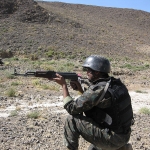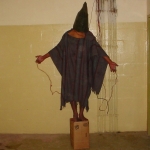Policing Afghanistan: Obama's New Strategy
%media%
Video by Ronald Nobu Sakamoto and Pratap Chatterjee
A new strategy for Afghanistan and Pakistan will be unveiled by President Barack Obama this week. A centerpiece of the new strategy is a plan to ramp up the training of the Afghan army and police at a cost of some $2 billion a year, an astronomical sum in Afghanistan where the entire government budget is about half that amount. Another key part of the plan is expected to be an effort to divide and conquer the Taliban with a mix of negotiations and targeted missile strikes in Pakistan.
CorpWatch, in association with KPFA radio, traveled to Afghanistan recently to interview a variety of Afghans from students to parliamentarians on their views of what Obama should do in their country. A video version of our interviews can be seen here.
Sitting in his darkened apartment in Kabul, a victim of the many power cuts in the capital city, Mir Ahmed Joyenda, an Afghan member of parliament, summed up the hopes and anxieties of many Afghans when he told us: "First of all, they should build (up) the Afghan army to defend the country. Second of all they should not plan attacks by B52s, Chinooks or pilot-less planes, they should have coordination with the Afghan army. Thirdly they should change their policy on the economic development of Afghanistan - it should be tangible for the people to have change in their lives."
Obama's new plan, which will aim to double the current size of the security forces to 400,000 troops and national police officers, may reassure Joyenda, but the ongoing program of missile strikes will not. Whether or not Obama will significantly increase and improve economic assistance to Afghanistan is a question that will only be answered over time.
To date most foreign economic assistance to Afghanistan has targeted the Taliban strongholds and the opium growing areas in the South, ignoring the needs of the majority of the country. Even the ancient Silk Road town of Bamiyan, the country's largest tourist attraction, with stunning archaeological and natural beauty (and the former site of the millennia-old Buddhas of Bamiyan, dynamited by the Taliban in 2001), has been ignored by the United States. A CorpWatch and KPFA video on the lack of basic services such as electricity and potable water in this region may be seen here.
The Obama plan to police Afghanistan and Pakistan and target the Taliban was coordinated at the National Security Council by Bruce Reidel, a 29-year veteran of the Central Intelligence Agency, who is a firm believer in the global war on terror (although that title has been quietly withdrawn by the Obama administration). The New York Times summed up Riedel's views as "one of a chorus of terrorism experts who see the terrorist network's base in the mountains of Pakistan as America's greatest threat" - a theory he has been working since 1981 when he was assigned to track what he calls the "birth of the global jihad" - notably focusing on an Egyptian physician named Ayman al-Zawahiri. Reidel recently published a book at the Brookings Institute titled: "The Search for Al Qaeda."
Contracting out Police Training
Who will train the tens of thousands of new police officers and soldiers? We await the answer to this question but there is a fairly good chance that some of it will be contracted out to companies like Virginia-based DynCorp who have previously been awarded multiple projects to train the Afghan police.
DynCorp's latest contract is a one-year-old U.S. State Department funded pilot project to reform the Afghan police called "Focused District Development" (FDD) that was initially directed by Major General Bob Cone, the former commanding general of the Combined Security Transition Command- Afghanistan.
The Afghan police, who can be seen speeding around the country in their brand new green Ford Ranger pickup trucks (paid for by the U.S. government), have long been considered to be inefficient or corrupt. "Officers aren't trained to be beat cops, much less to fight insurgents, say U.S. military and local Afghans. Many smoke hashish. Some demand illegal "taxes" from drivers on nearby roads. Often, the local police force is more of a militia answering to the local strongmen," wrote Soraya Sarhaddi Nelson, a National Public Radio (NPR) reporter last year.
This popular view was backed up by a 2007 study done by the United Nations Assistance Mission to Afghanistan. The study found negative information -including assertions of involvement in drug trafficking, corruption and assaults - on 939 (38 percent) of 2,464 officers it reviewed.
Another problem is the existence of "ghost policemen" - fictitious names on personnel rolls that allow police chiefs to collect extra payments. A 2007 Pentagon census of the Afghan National Police in several provinces could not confirm the existence of about 20 percent of uniformed police and more than 10 percent of border police listed on Ministry of Interior payroll records.
This is despite an extensive $10 billion training and support program funded by the U.S. for the Afghan Ministry of Interior (MOI) and Afghan National Police (ANP). A total of $653.5 million has been spent on Afghan police salaries to date, with the remainder of the money presumably going to equipment, infrastructure and salaries of U.S. government and contractor personnel.
Some of that money appears to have been wasted or stolen, according to several reviews done by the General Accounting Office (GAO), the investigative arm of the U.S. Congress. A 2005 GAO report noted that, "some recently trained police were forced to give their new equipment to more senior police and were pressured by their commanders to participate in extorting money from truck drivers and travelers." In 2008, a State Department investigation found that newly trained police were being assigned into an "unreformed environment" to work with untrained or corrupt colleagues, defeating the purpose of the training.
A 2008 GAO report was just as scathing. In a presentation to the U.S House of Representatives Subcommittee On National Security And Foreign Affairs, Congressman John Tierney summed up the findings on the 433 Afghan National Police units: "Zero are fully capable, three percent are capable with coalition support, four percent are only partially capable, 77 percent are not capable at all, and 68 percent are not formed or not reporting."
In an effort to combat these failures, notably the corruption and local loyalties that hampered past efforts to train individuals, DynCorp (which also ran the previous training contracts) was tasked to run the newly designed FDD program. Instead of training individual officers, DynCorp was asked to first assess each police district's organization, training, facilities and judicial infrastructure. Then the entire police unit was removed from their district for eight weeks of full-time training, segmented into basic training for all untrained recruits; advanced training for recruits with previous training; and management and leadership training for officers.
At a briefing in Camp Eggers in Kabul last November just before he relinquished his post, Cone explained that DynCorp was tasked with ongoing mentorship after the police returned to their districts: "I think that's really important is that we have these police mentor teams that stay and live with the police in the districts to perhaps keep them - in terms of - keep them from returning to some of their previous behavior, but more importantly keep them tied into the logistics system, the pay system, weapons accountability, et cetera, make sure they're performing as a competent police force."
So far the DynCorp FDD police training project has had mixed success, according to NPR's Nelson who traveled to Patkia province to see the new graduates in action earlier this month. She met with the Afghan major general in charge of the border provinces, Nabi Jan Molakheil, who is loyal to the government in Kabul instead of the local war lords.
Molakheil's battalion commanders "have lied about how many men they had on their rosters in the first place: a lie that allowed them to pocket Western money being paid for border police salaries and upkeep. A third of his commanders were removed last year after being accused of corruption. Two more were summoned to the interior ministry in Kabul in the past couple weeks to answer similar charges."
Nelson also observed that the border police "don't go on patrol a lot, either, relying instead on feral dogs to attack people sneaking across the border via remote goat trails or forest paths. Nor do these guards always check the handful of cars that cross into the area. The guards barely glance at a pickup that rumbles past, hauling a mound of unseen items covered by a tarp. The driver is a local, they say dismissively, just a shopkeeper who went to Pakistan for the day."
Back up for Nelson's report comes from a newly issued report by the GAO, also released earlier this month. The GAO quoted a February 2009 review by the Pentagon that assessed just 19 percent of FDD-retrained units as "capable of conducting missions," 25 percent as capable of doing so with outside support, 31 percent as capable of partially doing so with outside support, and 25 percent as not capable."
The GAO report says that one of the key achievements of the program has been to reform the top-heavy command structure of the security forces by cutting the officer corps from about 17,800 to about 9,000, reducing the percentage of high-ranking officers, while increasing pay for all ranks.
Some 55 percent of the 17,800 officers screened for "professionalism and integrity" apparently passed the test but the GAO was unable to review the results because the State Department "did not systematically compile its records." (A UN Assistance Mission to Afghanistan review of the officers also noted that 10,000 names turned up no records in any database, making assessment difficult.)
Despite these failings, Obama is expected to take up recommendations from the Combined Security Transition Command-Afghanistan (CST-A) to expand the FDD system to a total of 399 police mentor teams - 365 district teams and 34 provincial level teams. CSTC-A wants to implement a three-year planning model that would have 250 police mentor teams fielded by the end of December 2009 and the remaining 149 teams fielded in districts by October 2010. The Pentagon has also asked for an additional 1,500 additional military personnel to complement the civilian police trainers under this FDD expansion plan.
(FDD is not the only police training program in Afghanistan. A similar project, called In-District Reform (IDR), is under way in Herat province, where the training is provided by the U.S. Marines. Under this program, only half the police are taken out of their district for training while the Marines provide a temporary "surge" to provide back up. The IDR program is also different from FDD in that it provides a two-week collective skills training program.)
The job of fulfilling Obama's new plan will fall to Cone's successor, U.S. Major General Richard Formica, who took over the job as commanding general of the Combined Security Transition Command-Afghanistan on December 28th, 2008.
DynCorp is already hoping to win these contracts. William L. Ballhaus, DynCorp's CEO, told financial analysts in February that the company was "seeing the potential for increased demand for our services in Afghanistan and we hope over the next few months to start to get some more insight into the ramp up for trainers and advisors for police training."
Lack of "Basic Understanding"
Will the new plan succeed? Christine Fair, co-author of a recent U.S. Institute of Peace (USIP) report on the need for new strategy in Afghanistan says that the problems with foreign aid in the last several years are deep rooted.
"The lack of oversight - or even basic understanding - of the universe of international assistance programs at work in Afghanistan was one of the most striking findings of this report," says Fair. "The international community has shown a remarkable commitment to Afghanistan through its provision of resources and personnel, but only a fraction of that commitment is being met."
One example Fair cites is the 67 percent shortfall in international mentors for the police and a 30 percent shortfall for the army. Fair's report says that since 2001, the U.S. and international community have focused predominantly on top-down security efforts, including the establishment of an Afghan National Police and Afghan National Army. "But the deteriorating situation and local nature of the insurgency require supporting district-level institutions that are Afghan-led and locally appropriate, with safeguards and oversight to establish order and deliver services," concludes the USIP report.
Yet even more tragic is the fact so little effort is being put into answering basic economic needs. "It's very ironic that we are trying to build a sovereign state that can't afford the security architecture we are building for it," Fair told NPR. Money is not the biggest problem, she says. "The chief problem in Afghanistan is not necessarily a lack of resources, but a better use of resources and one that builds governance, not weakens it."
- 18 CSC/ DynCorp
- 23 Private Security
- 104 Globalization
- 106 Money & Politics
- 187 Privatization



